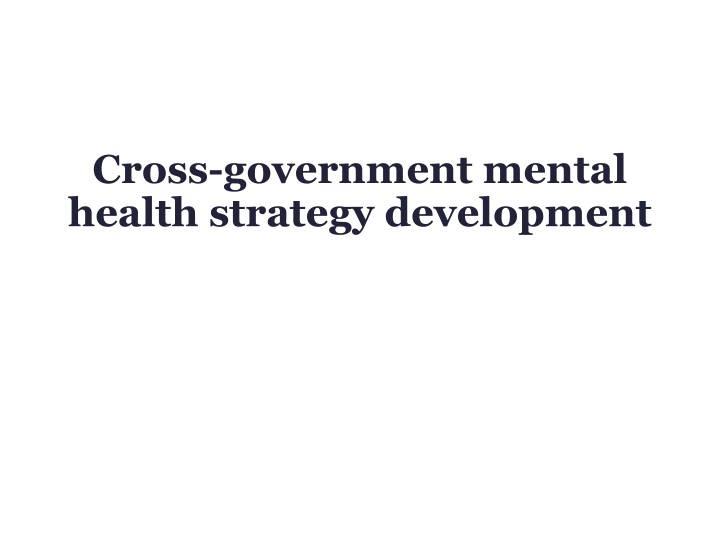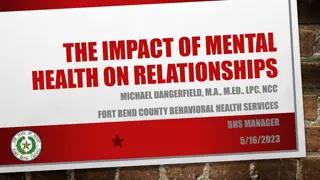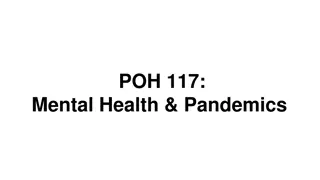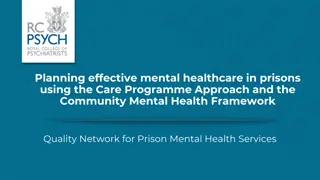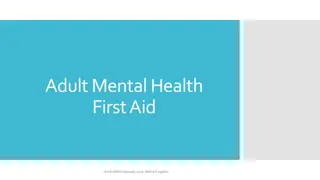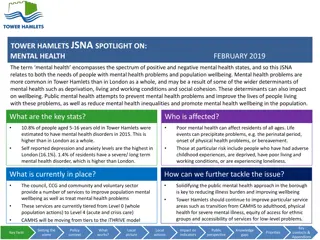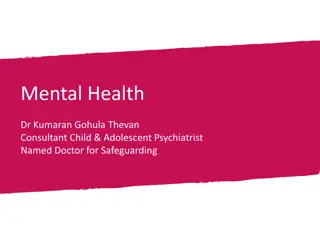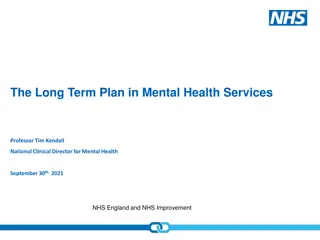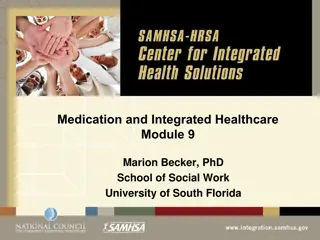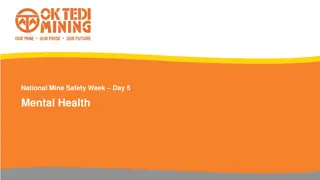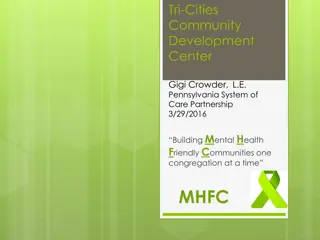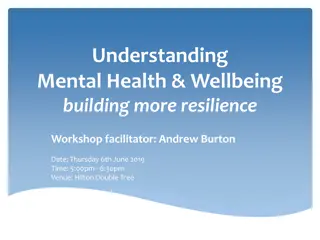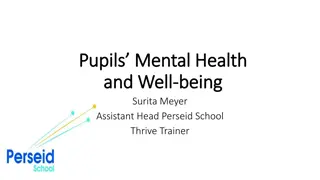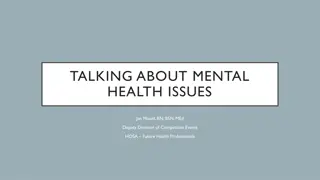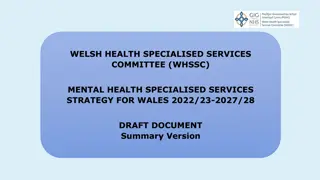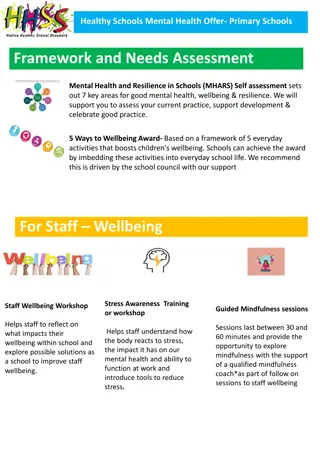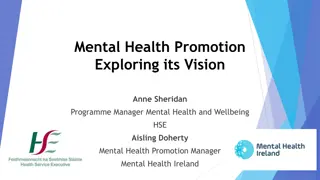Transformational Approach to Mental Health Strategy
Extensive mental health challenges require a fundamental shift in approach towards a shared responsibility across government and communities. The focus is on evidence-based strategies, early intervention, and expanding services to address varying mental health needs. Embracing new technologies and modern therapies is crucial. A cross-government response is necessary to improve mental health and reduce associated negative outcomes, fostering public education and acceptance.
Download Presentation

Please find below an Image/Link to download the presentation.
The content on the website is provided AS IS for your information and personal use only. It may not be sold, licensed, or shared on other websites without obtaining consent from the author.If you encounter any issues during the download, it is possible that the publisher has removed the file from their server.
You are allowed to download the files provided on this website for personal or commercial use, subject to the condition that they are used lawfully. All files are the property of their respective owners.
The content on the website is provided AS IS for your information and personal use only. It may not be sold, licensed, or shared on other websites without obtaining consent from the author.
E N D
Presentation Transcript
Cross-government mental health strategy development
1 Transformational Shift for Mental Health The mental health problem is extensive simply doing more of the same will not fix the problem and the challenges will increase Moving forward will require a fundamental shift in our approach A shared responsibility across government and communities The cost implications and social, economic and personal impacts associated with poor mental health are substantial. An evidence-based approach, using data and evidence to inform decision making and better target responses Mental disorders, including addiction, are highly prevalent, with many people not presenting or receiving appropriate support. A life-course approach, recognising the opportunity to address known risk factors and build resilience across the life course The stressors of modern life, including digitalisation and urbanisation, and the context in which we live mean demand for mental health supports will increase. and a greater focus on The longer mental health disorders are left untreated, the greater the cost Promoting mental wellbeing and resilience, starting early in life Most mental disorders begin early in life, and opportunities to diagnose disorders early are missed, meaning many do not receive appropriate support. Prevention and early intervention Acute services for people with mental health needs are facing pressure Supporting those with mild to moderate mental health needs Improving and expanding services and support at the acute end of the needs spectrum, including in the criminal justice sector and crisis response services The health system has historically focused on meeting the needs of those with the most severe mental disorders, and use of acute mental health services has increased. Demand for crisis response services related to mental health and/or social distress is also increasing, with limited capacity to respond. Public education and acceptance of mental health/ill health as just as important as other forms of health/ill health We are not investing in building and supporting mental health Embracing new technology and modern therapies, e.g. e- therapies
2 Shared Responsibility The relationship between poor social and justice outcomes and poor mental health outcomes is complex and interdependent Poor mental health, including addiction, is both a contributor to, and outcome of, other poor social and justice outcomes. Mental illness can therefore lead to compounding disadvantage for people already at risk of poor outcomes. Sometimes there is clear link between addressing poor mental health and reducing other negative outcomes: Certain population groups continue to experience poorer mental health, social and justice outcomes than others. Young people with mild to moderate mental health are three times more likely to be benefit dependent.1 Sometimes mental illness may co-occur with other negative outcomes, increasing the challenges facing other services: Vulnerable Children, Oranga Tamariki 52% of female prisoners have posttraumatic stress disorder, but intervening early to change the mental health and corrections outcomes is likely to require a response from another sector (e.g. addressing family violence).2 Not engaging with services Education Each sector engages with populations who also have mental health needs. Corrections Welfare Population with mental health needs There are also portions of the population with mental health needs who are not engaging with other government services or accessing support for their mental health needs. This results in shared client populations across government Justice Housing Police Health No single agency can address the complex and overlapping issues underpinning poor mental health and other social and justice outcomes. Therefore a cross-agency response is needed to prioritise and direct efforts across government to improve mental health and reduce associated negative outcomes
3 Vulnerable Children and Young People Vulnerable children and young people live complex lives, and without earlier and culturally appropriate wellbeing support, are more likely to experience worse outcomes There is a very high prevalence of emotional, behavioural and mental health problems, especially in those who come into contact with the Care and Protection and Youth Justice systems Health related needs of children at risk of entering care from 1 July 31 Dec 20161 Treasury analysis showed that by 15 years old, three out of every 10 of those who were notified to Child, Youth and Family, and nearly five out of every 10 who are placed in care, have identified mental health issues, compared to two out of every 10 of those who do not have contact with Child, Youth and Family.2 Health needs identified through Gateway Assessments % type of need Mental health, behavioural, emotional and adolescent concerns Primary health concern 74% 50% Physical health not primary Dental Hearing Neurodevelopmental, learning, delay, speech and language 38% 37% 16% 16% Appropriate support is needed to mitigate harm and address trauma and vulnerability Access to clinical mental health services is inconsistent, and availability of services does not always match the identified need Poor parental mental health is a common issue A recent survey of young people in residences aged between 12 to 18 years found that 67% had parents with alcohol and other drug issues and 54% of the girls had a parent with a mental health condition.3 Early support (where a threshhold for statutory intervention is not met) will be critical to support prevention and early intervention goals for MVCOT. Using existing cross-agency services such as Gateway Assessments and identifying supports during transitions are important points of intervention. M ori are overrepresented Currently around 230,000 children and young people under age 18 may experience vulnerability at some point during their childhood, and around six out of 10 of this group are likely to be M ori.4
4 Education We need to intervene early to identify and prevent poor mental health in childhood and later in life The majority of New Zealand children and young people feel safe, supported and have a sense of belonging at school. Half of all lifetime cases of mental illness start by age 14 and three quarters of all lifetime cases start by 241,2 Current supports include: Key competencies and health/wellbeing strands of curricula PB4L, including programmes under the Youth Mental Health initiative Specialist support for behaviour issues and conduct disorder Guidance counsellors in high schools School based health services However, our rates of bullying and other risk factors of poor mental health are worse than the OECD average. Some communities are particularly affected such as M ori, Pasifika and those that identify as LGBTQIA.3 38% of female and 23% of male students reported feeling down or depressed for at least two weeks in a row over the last 12 months.4 Ensuring that young people have strong engagement and success in their schooling, in safe and positive environments, is a key way to support positive mental health and wellbeing. For around 1 in 10 children, being bullied or picked on has been a consistent experience since they were 2 years old.5 In addition, we need to make sure that we identify and meet specific mental health needs amongst students earlier and better, whether mild, moderate or severe. Potential improvements within the education system may include: 1. Further efforts to reduce bullying and to strengthen early childhood education and school cultures. 2. Increased focus on the effective development of social and emotional skills, including resilience and health/wellbeing, of children and young people. 3. Better assessments of all children and young people at key points. We could make changes to timing and expand the coverage of B4 school checks and HEEADSSS assessments as well as introducing new, earlier, targeted assessments for those identified as high risk. 4. Improve referrals and access to the right support and treatment, at the right time, both early in life and early in the course of any presenting problems look at expanding school-based health services and exploring other multidisciplinary approaches. Early assessment is essential to help prevent mental health issues We have effective measures that could be utilised more widely, such as B4 school checks and HEEADSSS assessments.
5 Welfare There is a strong association between unemployment and poor mental health $11.1 billion People with mental health conditions have worse employment outcomes than others, including other disabled people. MSD has not had much success improving employment outcomes for mental health clients: Over 40% (approx. 57,600) of all health and disability benefit recipients primary health barrier to work is mental illness.1 Estimated total lifetime welfare liability.2 $1.5 billion Estimated total annual cost across agencies.3 This client group has almost doubled since 2000 Since 2000, the number of clients with a mental illness as the primary health barrier to work has risen by approximately 31,000to about 60,000 people which equates to about $5.5 billion increase.4 This is likely an underestimate of benefit recipients with mental illness, e.g. a further 25,300 beneficiaries (not receiving income support due to mental illness or addiction) accessed mental health and addictions services within the last two years.5 Young people (12-24) with mild to moderate mental health issues are three times more likely to be benefit dependent6 15% get their main income from work compared to 60% of the total youth population Twice as likely to have no qualifications as youth with no mental health condition Have a 41% finding of reported abused compared to 7% of the total youth population 14% have a significant Corrections sentence compared to 1% for those with no mental health condition Twice as likely to have children as compared to the total youth population
6 Housing There is a significant association between poor mental health and a need for housing support1 25% of primary applicants on the social housing register disclose they have a common or significant mental health condition. Rates of hospitalisation for severe mental illness are approximately 3x higher for social housing tenants than in the rest of the population. Approximately 6,700 social housing tenants receive Supported Living Payment or Jobseeker Support Health and Disability because their primary health barrier to working is mental illness or addiction. $1.2 Billion (total) $182,000 (individual) / Estimated lifetime housing liability (including IRRS, AS, TAS) Better prevention and support for people with mental health conditions is likely to help people establish and sustain private market tenancies and reduce the long-term demand pressure on the housing support system. and stable housing situations can help improve mental health Rates of hospitalisation for mental and behavioral disorders decline by about 20%following placement in social housing and are sustained for at least two years after placement.2 Housing First has been shown to improve clinical and social outcomes for individuals with severe mental illness and addiction.3-5 The Strategy is an opportunity to develop integrated housing, employment and other services that are tailored to meet the needs of people with varying levels of severity and risk for mental illness.
7 Health The health system has historically focused on meeting the needs of those with the most severe mental illness People who accessed specialist & primary mental health services from 1 Jul 15 to 30 Jun 161 This indicates: Mental health services are mainly geared towards a small proportion of the population. A significant proportion of the population with mental health needs are only receiving pharmaceutical support through primary care interactions. There is likely unmet mental health need in the 84% of the population who were not identified as having accessed mental health services or receiving pharmaceuticals. Some population groups are over/under-represented mental health services users and continue to experience poorer mental health outcomes than others M ori are overrepresented users of mental health services, with the exception of pharmaceutical use3; but after accounting for sex, age, income and education, M ori prevalence (23.9%) of any psychiatric disorder was significantly higher than those of European/Other descent (20.3%), with Pacific people similar to European/Other (19.2%).4,5 New Zealanders experience a range of mental health conditions 2014/15 conditions of mental health service users2 Condition Number of people % of people with MH condition Mood and anxiety Unspecified mental disorder Substance use 403,830 60.9% Without adjusting for these confounding factors, Pacific people had a 12-month prevalence rate of 25.0%. 6 277,767 41.9% 155,475 23.5% M ori are more likely to experience serious disorders and co-morbidities and have the highest 12-month prevalence of substance use disorders.7 ADHD 16,626 2.5% Psychotic 16,143 2.4% Pacific young people are approximately three times more likely to have attempted suicide within in the previous 12 months than New Zealand European students.8 Eating disorder 1,545 0.2% Personality disorder Other mental health condition People identified as having a mental health condition Note: Individuals may have more than one condition, so percentages will not sum to 100%. 1,251 0.2% The prevalence of mental disorder in the past 12 months is higher in young people and those with lower income or education or living in more deprived areas.9 753 0.1% 662,607 Service use is highest among young people, those in their late teens and 20s, and increases with the level of deprivation. 10 Long-term conditions are more prevalent in people with mental health conditions11 Over 9%of people with mental health conditions have one or more long-term health condition. In comparison, only 3% of people without mental health conditions have one or more long-term conditions.
8 Crisis Response People access mental health crisis services in a number of ways. Police resolve a number of these calls themselves, but may also be seen by people as a pathway into DHB crisis services DHB crisis services appear to be working at or near capacity. This may limit options for people seeking crisis response services Clients/occupied bed nights spent in a mental health acute inpatient or equivalent service1 Police referrals to DHB crisis response services3 These 24-hour care and treatment services are provided to people experiencing severe acute symptoms, requiring intensive input for a short period of time. 12000 11500 These services will be used by those who have severe needs. 11000 200000 10500 150000 10000 There are limited crisis response options for people with less severe needs. 100000 9500 50000 9000 0 8500 09/10 10/11 11/12 12/13 13/14 14/15 09/10 10/11 11/12 12/13 13/14 Unique clients seen by DHBs Occupied bed nights A number of initiatives across sectors have been implemented Police are seen by many people as being able to provide a quick and in-person 24/7 response to their crisis2 Providing specialist mental health training to recruits In 2016, Police received 46,359calls coded as mental health-related issues and attended 32,890of these (90every 24 hours). These incidents involve people who have not committed an offence. Trialling telephone triage staffed by mental health nurses to divert some mental health needs only calls, currently in the first phase of implementation Emergency calls to Police for mental health only reasons Taking people to ED for mental health assessments rather than having these assessments held in Police stations, where possible Note: 1M General Mental Health 1X Threatening/Attempted Suicide but there are opportunities for better health outcomes which may include These are non-clinical classifications determined by dispatch staff. Many people call Police when experiencing significant adverse life events, and may not be diagnosed with a mental illness. Piloting proven overseas first responder initiatives (such as co-response between ambulance or Police staff and mental health services) to improve the service provided to mentally unwell people Considering a range of sites for after-hours mental health assessments By 2020, if current trends continue unchecked, Police will attend about 43,000 mental health-related jobs (combined 1M and 1X) per year.
9 Criminal Justice System Offenders and defendants are more likely to use mental health services than the general public1 A high percentage of offenders and defendants have mental health needs or substance abuse issues Adults sentenced to prison 9,000 People proceeded against by Police 130,000 People charged in court 95,000 40% People with mental health needs at risk of coming into contact with the justice system 62% People starting community sentences 39,000 Before contact with the justice system Consider potential new services targeted at the cohort (to be identified) at risk of coming into contact with the criminal justice system before this occurs to provide alternatives to crisis response, outside of the justice system 51% 35% Prisoners have high rates of mental health and substance use disorders, and high levels of unmet need4 91% of all prisoners had a lifetime diagnosis of a mental health or substance use disorder, and 62% had this diagnosis in the past 12 months (cf 20% in the general population) Targeted and timely services at court People proceeded against have much higher rates of substance abuse2 Younger people charged in court have much higher rates of any mental health service use3 30% Prevalence of substance abuse / dependence (12 months either 24% side of 2012 justice interaction) 25% 64% 70% service use (12 months either side 21% Prevalence of any mental health 60% 20% of 2012 justice interaction) Nearly half (47%) of prisoners with a 12-month diagnosis of a mental health/substance use disorder had mental health treatment in the preceding year 15% 50% 42% 15% 10% 37% 40% 10% 30% Better tailored services may support improved outcomes for particular cohorts5 3% 5% 2% 1% <1% 20% 11% 10% 6% 0% 10% Pacific peoples had the highest prevalence of any mental disorder among prisoners, but had the lowest prevalence in the general population 0% 25+ 10 16 17 24 Age (years) People charged in court M ori prisoners had the highest prevalence of lifetime drug abuse and drug dependence disorders General public Potential improvements may include: Victims: Commission a matrix of evidence-based interventions to assist victims with mental health issues, including children/youth, to help participation in the system Potential improvements to the court process may include: Bolster support to defendants and victims with better targeted, co- ordinated and more timely services supported through an investment approach Women had nearly twice the prevalence of anxiety disorders than male prisoners 46% of 25-44 year old prisoners had a lifetime diagnosis of a mental health/substance use disorder Other potential improvements may include: Benchmark forensic beds to the size of the prison population to align investment with need Inside the justice system: Expand the nurses in Police watch houses initiative to assist Police to better manage and assess offenders who have health needs, including alcohol or drug and mental health problems, while in Police custody Provide more support to court staff (e.g. forensic court assessment and referral services) for defendants with mental health needs Pilot re-integration programmes for prisoners using therapeutic interventions and continuous care
10 Suicide and Self-Harm The suicide rate has remained relatively stable over the last decade The suicide rate has remained stable over the past 10 years. While it s good that the rate is not increasing, this suggests we need a different approach to preventing death by suicide. Every year over 500 people die by suicide, making it the third most common reason why people die younger than expected.1 Another 150,000 people think about taking their own life; around 50,000 make a plan to take their own life; and around 20,000 attempt suicide.2 Age-standardised rate (deaths per 100,000)3 20 15 10 2005 2006 2007 2008 2009 2010 2011 2012 2013 2014 Suicidal behaviour is more prevalent in people who are or have been in the care of Child, Youth and Family, Corrections or Police6 Suicide has a different prevalence in different groups Suicide rates tend to be highest among M ori, young men and those living in deprived areas.4 People who may have brushed the social or justice systems can experience worse outcomes than those with more intense engagement with the systems. Suicide rates by ethnicity and five-year age group (from 5 79 years of age), 2009 20135 For example, young people who have been notified to CYF but have not had a substantiated finding are more likely to self harm than young people with a substantiated finding. Rate per 100,000 45 Asian European & Other M ori Pacific All ethnicities 40 CYF abuse events and rates of self harm (approx.) in 0-18 year olds7 35 30 c.55% 60% 25 20 c.45% 50% 15 40% 10 30% 5 c.19% c.18% 0 20% 5 9 10 14 15 19 20 24 25 29 30 34 35 39 40 44 45 49 50 54 55 59 60 64 65 69 70 74 75 79 10% 0% Age group (years) Behavioural/ relationship difficulties Emotionally abused Neglected Abuse not found This suggests a need for targeted responses for those groups at higher risk of suicidal behaviour. This reinforces the opportunity to make better use of existing touch points across the social and justice systems.
11 References IDI disclaimer: The results in this report are not official statistics, they have been created for research purposes from the Integrated Data Infrastructure (IDI) managed by Statistics New Zealand. The opinions, findings, recommendations and conclusions expressed in this report are those of the author(s) not Statistics NZ, the Social Investment Unit or the Ministry of Health. Access to the anonymised data used in this study was provided by Statistics NZ in accordance with security and confidentiality provisions of the Statistics Act 1975. Only people authorised by the Statistics Act 1975 are allowed to see data about a particular person, household, business or organisation and the results in this report have been supressed to protect these groups from identification. Careful consideration has been given to the privacy, security and confidentiality issues associated with using administrative and survey data in the IDI. Further detail can be found in the Privacy impact assessment for the Integrated Data Infrastructure available from www.stats.govt.nz. The results are based in part on tax data supplied by Inland Revenue to Statistics NZ under the Tax Administration Act 1994. This tax data must only be used for statistical purposes. No individual information may be published or disclosed in any other form, nor provided to Inland Revenue for administrative or regulatory purposes. Any person who has had access to the unit-record data has certified that they have been shown and have read and understood section 81 of the Tax Administration Act 1994, which relates to secrecy. Any discussion of data limitations or weaknesses is in the context of using the IDI for statistical purposes and is not related to the data s ability to support Inland Revenue s core operational requirements. 2. Cross-Government Perspective 1. MSD internal memo (2017-02-20) Youth mental health data 2. Department of Corrections (2016) Comorbid substance use disorders and mental health disorders among New Zealand prisoners 7. Health 1. PRIMHD and Ministry of Health. Note: Primary mental health services included here are those that are additional to a general primary care response which are funded for specific population groups (youth, M ori, Pacific and low income). 2. Analysis of IDI and Ministry of Health data undertaken by PwC Australia. Note: Includes those who received pharmaceutical only support. Individuals can be diagnosed with more than one condition, so percentages will not sum to 100%. 3. Ibid. 4. Wells JE, Oakley Browne MA, Scott KM, McGee MA, Baxter J, Kokaua J. Te Rau Hinengaro: The New Zealand Mental Health Survey: Overview of Methods and Findings. Australian & New Zealand Journal of Psychiatry 2006; 40(10): 835-44 5. Baxter J, Kokaua J, Wells JE, McGee MA, Oakley Browne MA. Ethnic Comparisons of the 12 Month Prevalence of Mental Disorders and Treatment Contact in Te Rau Hinengaro: The New Zealand Mental Health Survey. Australian & New Zealand Journal of Psychiatry 2006; 40(10): 905-13. 6. Ibid. 7. Ministry of Health (2017) Mental health and addiction workforce action plan: 2017-2021 8. University of Auckland (2012) The Health and Wellbeing of New Zealand Secondary School Students in 2012: Pacific Young People (Findings from the Youth 12 national youth health and wellbeing survey) 9. New Zealand Medical Association (2011) Fact and action sheets on health inequities 10.Analysis of IDI and Ministry of Health data undertaken by PwC Australia 11.Ibid. 3. Vulnerable Children and Young People 1. Gateway assessments (2017) data was extracted 3 April 2017 for the July to December 2016 period by Ministry of Social Development. Note: Assessments of mental health needs are not limited to a diagnosed mental health disorder. The assessment is conducted by a child health specialist and may be referred to more specialist assessment if required. The assessment is a snapshot, and is consistent with international literature. There is often overlap in the nature of needs categories, as children may present with multiple needs reflective of their complex lives. 2. NZ Treasury (2015). Using Integrated Administrative Data to Identify Youth Who Are at Risk of Poor Outcomes as Adults. Analytical Paper 15/02. http://www.treasury.govt.nz/publications/research-policy/ap/2015/15-02/ap15-02.pdf (p18) 3. McKay S, Bagshaw S. The health needs of young people in CYF residential care. The Collaborative for Research and Training in Youth Health and Development Trust. July 2009. 4. Expert Panel Final Report: Investing in New Zealand s Children and their Families (December 2015) https://www.msd.govt.nz/documents/about-msd-and-our-work/work-programmes/investing-in-children/investing-in- children-report.pdf 8. Crisis Response 1. Ministry of Health analysis of PRIMHD dataset T05 data 2. New Zealand Police, Internal analysis of call data 3. Ministry of Health analysis of PRIMHD dataset T01 data 4. Education 1. Kessler, R.C. et. al. (2005) Lifetime prevalence and age-of-onset distributions of DSM-IV disorders in the National Comorbidity Survey Replication. Arch Gen Psychiatry. 2005 Jul, 62(7):768. 2. Analysis undertaken by the SIU 3. Ministry of Education (2017) PISA 2015 New Zealand Students Wellbeing Report. Wellington, New Zealand. P. 48. 4. Clark, T. C. et. al. (2013). Youth 12 Overview: The health and wellbeing of New Zealand secondary school students in 2012. Auckland, New Zealand: The University of Auckland. 5. Morton, S.M.B et. al. (2017) Growing Up in New Zealand: A longitudinal study of New Zealand children and their families. Now We Are Four: Describing the preschool years. Auckland: Growing Up in New Zealand. p 30. 9. Criminal Justice System 1. This analysis (except for Prison data) was conducted in the IDI using linked Justice and Ministry of Health mental health data. It relates to use of mental health services in 12 months either side of 2012 Justice sector interaction. The general public data uses Census data. The Prison statistic is sourced from the Corrections prions survey Comorbid substance use disorders and mental health disorders among NZ prisoners and relates to a 12-month diagnosis of a mental health or substance use disorder. Access to the data presented was managed by Statistics New Zealand under strict micro-data access protocols and in accordance with the security and confidentiality provisions of the Statistics Act 1975. These findings are not Official Statistics. The opinions, findings, recommendations, and conclusions expressed are those of the researchers, not Statistics NZ, the Ministry of Health or the Ministry of Justice. 2. Ibid. 3. Ibid. 4. Department of Corrections (2016) Comorbid substance use disorders and mental health disorders among New Zealand prisoners 5. Ibid. 5. Welfare 1. Provided by MSD. 2. Ibid. 3. MSD briefing (2016-08-23) What support do clients receive? . Costs include MSD income support, supplementary assistance and income related rent subsidy, Ministry of Health DSS, mental health and addictions, hospital and pharmaceutical costs. Cost data is from 2010/11, as it is the most recent year for which Ministry of Health mental health and addictions cost data is available in the IDI. Health costs are not comprehensive, e.g. primary health costs are not included. ACC costs are not included due to limitations with ACC data held in the IDI, which includes the total support costs for an individual not broken down by year 4. Provided by MSD. 5. Ibid. 6. MSD internal memo (2017-02-20) Youth mental health data 10. Suicide and Self-Harm 1. Ministry of Health New Zealand Mortality Collection, reported on in Suicide Facts: Deaths and intentional self-harm hospitalisations series 2. Ministry of Health (2006) Te Rau Hinengaro: The New Zealand Mental Health Survey. Statistics New Zealand 2013 population estimates were used to calculate an estimate of the number of people based on prevalence figures. 3. Ministry of Health New Zealand Mortality Collection. Age-standardised rate is per 100,000, standardised to the WHO standard population aged 0 64 years. 4. Ministry of Health New Zealand Mortality Collection, reported on in Suicide Facts: Deaths and intentional self-harm hospitalisations series. And New Zealand Medical Association (2011) Fact and action sheets on health inequities 5. Ministry of Health New Zealand Mortality Collection, reported on in Suicide Facts: Deaths and intentional self-harm hospitalisations series 6. Suicide Mortality Review Committee (2016) Suicide Mortality Review Committee Feasibility Study 2014 15 7. Analysis undertaken for the Ministry of Health by Sapere 6. Housing 1. Information provided by MSD. 2. Zhang, J., & Howden-Chapman, P. (2010). Health Impacts of Social Housing: Hospitalisations in Housing New Zealand Applicants and Tenants, 2003-2008. 3. Patterson M, Moniruzzaman A, Palepu A, et al. Housing First improves subjective quality of life among homeless adults with mental illness: 12-month findings from a randomized controlled trial in Vancouver, British Columbia. Social Psychiatry and Psychiatric Epidemiology. 2013;48(8):1245-1259. 4. Kirst, M., Zerger, S., Misir, V., Hwang, S., & Stergiopoulos, V. (2015). The impact of a Housing First randomized controlled trial on substance use problems among homeless individuals with mental illness. Drug and alcohol dependence, 146, 24-29. 5. Tsemberis S, Kent D, Respress C. Housing stability and recovery among chronically homeless persons with co-occurring disorders in Washington, DC. American Journal of Public Health. 2012;102(1):13-6.
